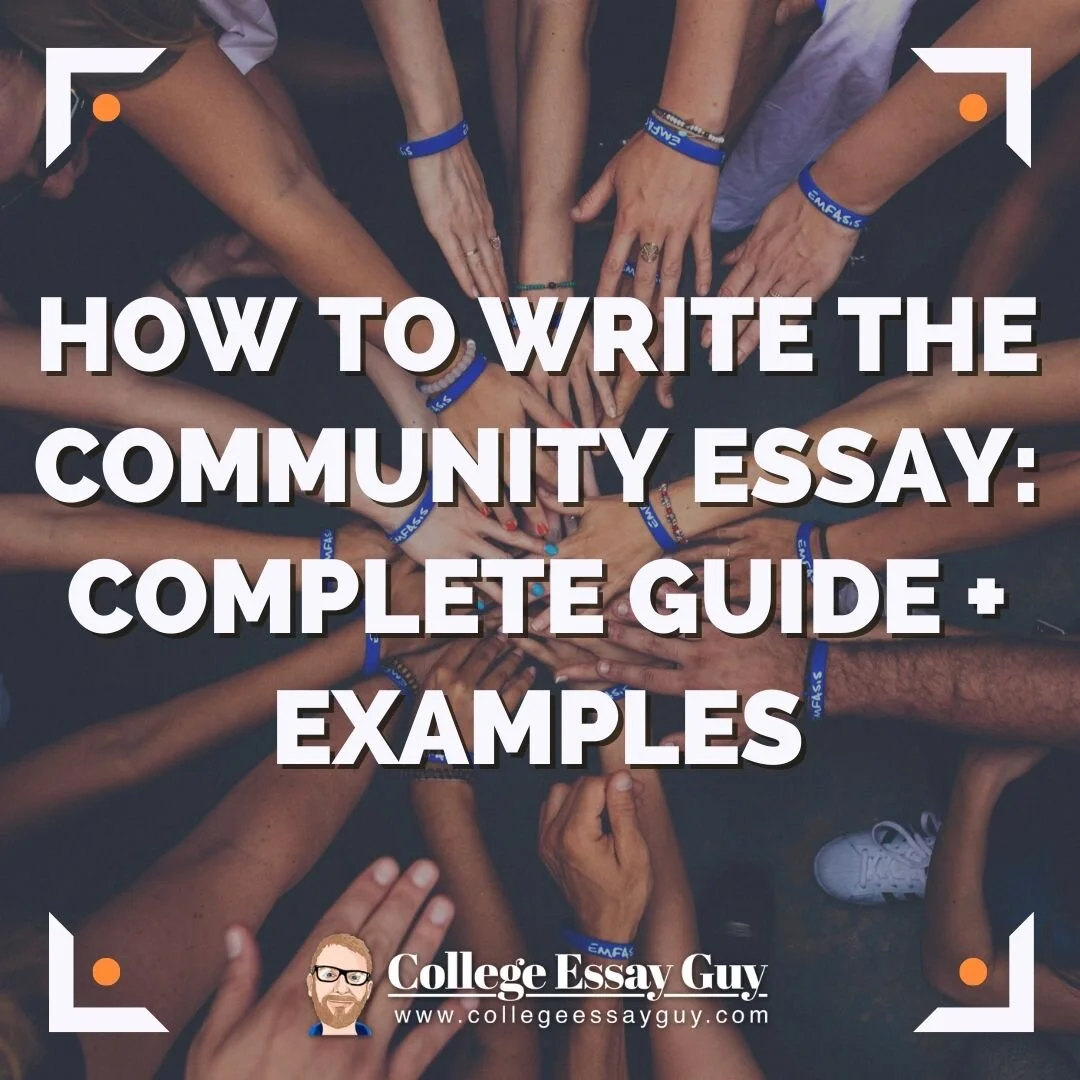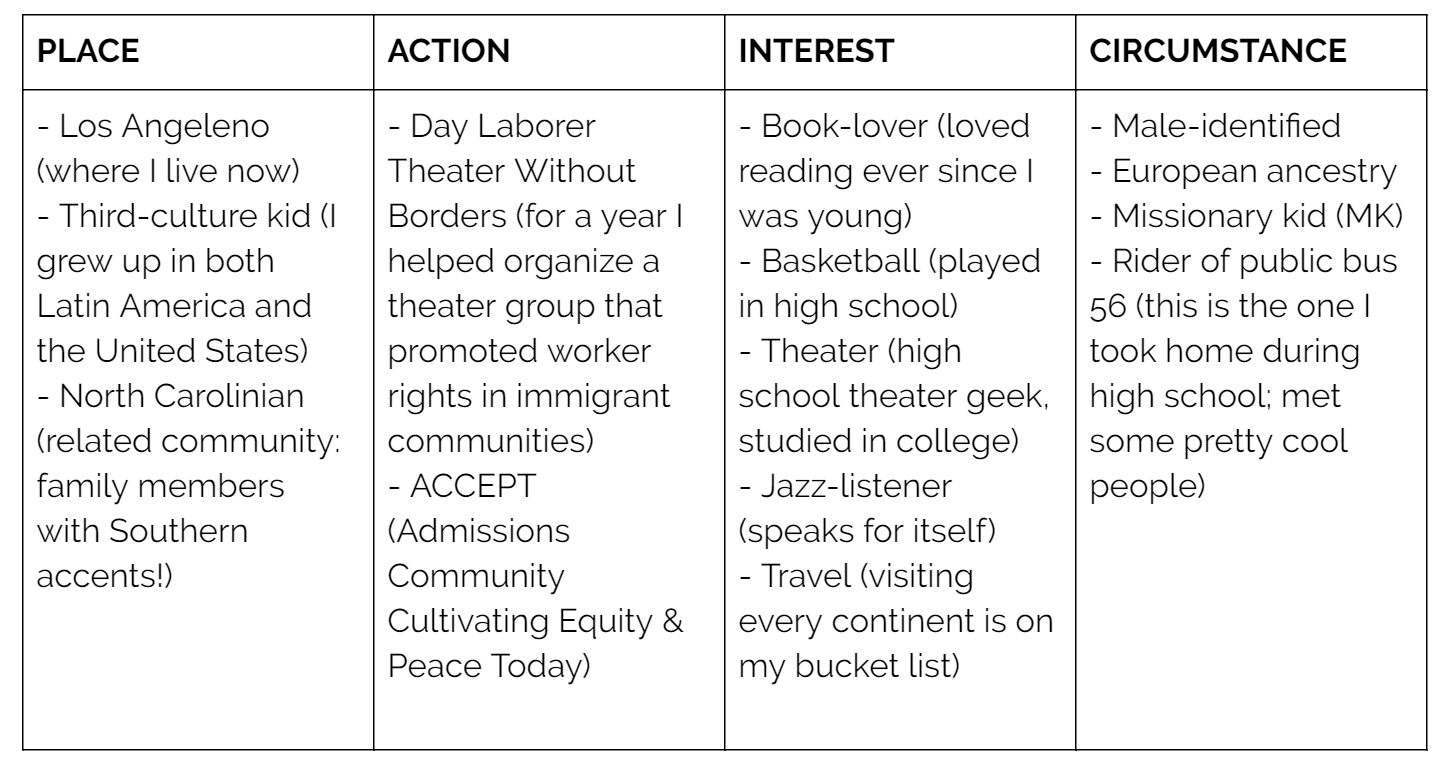TABLE OF CONTENTS
(click to scroll)-
Introduction
- Step 1: Decide What Community to Write About
- Step 2: The BEABIES Exercise
- Step 3: Pick a Structure (Narrative or Montage)
How to Write The Community Essay
Community Essay Example: Storytellers
The Uncommon Connections Exercise
Community Essay Example: The Pumpkin House (Plus Ethan's Analysis)
Introduction
On the Common Application, a number of colleges have begun to require that students respond to a supplemental essay question that sounds something like this:
Tell us a bit more about a community you are a part of.
Here is the exact wording from a few schools:
University of Michigan: “Everyone belongs to many different communities and/or groups defined by (among other things) shared geography, religion, ethnicity, income, cuisine, interest, race, ideology, or intellectual heritage. Choose one of the communities to which you belong, and describe that community and your place within it. (250 words)”
Duke University: “We seek a talented, engaged student body that embodies the wide range of human experience; we believe that the diversity of our students makes our community stronger. If you'd like to share a perspective you bring or experiences you've had to help us understand you better—perhaps related to a community you belong to, your sexual orientation or gender identity, or your family or cultural background—we encourage you to do so. Real people are reading your application, and we want to do our best to understand and appreciate the real people applying. (250 words)
(Old) Brown University: “Tell us about a place or community you call home. How has it shaped your perspective? (250 words)
I love this essay question.
Why? Because, while this essay is largely asking about your place within that community, it is a great opportunity to share more about you, and how you will most likely engage with that community (or other communities) on your future college campus.
It’s a chance to say: “Here’s how I connect with folks in this community. And if accepted to your college, I’ll probably be active in getting involved with that same community and others on your college campus.”
And colleges want students who are going to be active in engaging with their community.
How to Write The Community Essay
Step 1: Decide what community you want to write about
How? This may seem obvious, but it can be really helpful to first brainstorm the communities you’re already a part of.
Here’s how:
Create a “communities” chart by listing all the communities you’re a part of. Keep in mind that communities can be defined by...
Place: groups of people who live/work/play near one another
Action: groups of people who create change in the world by building, doing, or solving something together (Examples: Black Lives Matter, Girls Who Code, March for Our Lives)
Interest: groups of people coming together based on shared interest, experience, or expertise
Circumstance: groups of people brought together either by chance or external events/situations
Use four columns in your chart, like this.
Your turn.
What communities are you a part of?
Spend 5-10 minutes making a list of as many as you can think of.
In fact, here’s a simple GoogleDoc you can download and fill in right now.
Once you’ve completed that exercise for several of the communities you are a part of, you might start to see one community seems to be the most obvious one to write about.
Go with the one that you feel gives the best chance to help you share more about yourself.
Step 2: Use the BEABIES exercise to generate your essay content
Once you’ve chosen a community or two, map out your content using the BEABIES Exercise. That exercise asks:
What did you actually do in that community? (Tip: use active verbs like “organized” and “managed” to clarify your responsibilities).
What kinds of problems did you solve (personally, locally, or globally)?
What specific impact did you have?
What did you learn (skills, qualities, values)?
How did you apply the lessons you learned in and outside of that community?
Don’t skip that step. It’s important.
Step 3: Pick a structure (Narrative or Montage)
The Narrative Structure. This structure works well for students who have faced a challenge in this community. Otherwise, the Montage Structure works well.
Consider answering these three questions in your essay if you choose the Narrative Structure:
What challenge did you face?
What did you do about it?
What did you learn?
Here’s an example of a narrative “community” essay based on a challenge that tackles those three questions, roughly in order:
Community Essay Example: East Meets West
I look around my room, dimly lit by an orange light. On my desk, a framed picture of an Asian family beaming their smiles, buried among US history textbooks and The Great Gatsby. A Korean ballad streams from two tiny computer speakers. Pamphlets of American colleges scattered on the floor. A cold December wind wafts a strange infusion of ramen and leftover pizza. On the wall in the far back, a Korean flag hangs besides a Led Zeppelin poster.
Do I consider myself Korean or American?
A few years back, I would have replied: “Neither.” The frustrating moments of miscommunication, the stifling homesickness, and the impossible dilemma of deciding between the Korean or American table in the dining hall, all fueled my identity crisis.
Standing in the “Foreign Passports” section at JFK, I have always felt out of place. Sure, I held a Korean passport in my hands, and I loved kimchi and Yuna Kim and knew the Korean Anthem by heart. But I also loved macaroni and cheese and LeBron. Deep inside, I feared I’d labeled by my airport customs category: a foreigner everywhere.
This ambiguity, however, has granted me the opportunity to absorb the best of both worlds. Look at my dorm room. This mélange of cultures in my East-meets-West room embodies the diversity that characterizes my international student life.
I’ve learned to accept my “ambiguity” as “diversity,” as a third-culture student embracing both identities.
Do I consider myself Korean or American?
Now, I can proudly answer: “Both.”
— — —
(250 words)
While this author doesn’t go into too much depth on the “What did you do about it?” question named above, we do get a sense of the challenge he faced and what he learned.
For more on how to use the narrative structure, check out the free guide to writing the personal statement.
The Montage Structure. This is another potential structure, often times great for essays that don’t necessarily focus on a particular challenge.
Here’s a great example:
Community Essay Example: Storytellers
Storytellers (Montage Structure)
I belong to a community of storytellers. Throughout my childhood, my mother and I spent countless hours immersed in the magical land of bedtime stories. We took daring adventures and explored far away lands. Imagination ran wild, characters came to life, and I became acquainted with heroes and lessons that continue to inspire me today. It was a ritual that I will never forget.
In school I met many other storytellers—teachers, coaches, and fellow students whose stories taught me valuable lessons and enabled me to share stories of my own. My stories took shape through my involvement with theatre. I have learned that telling stories can be just as powerful as hearing them.
When I tell a story, I can shape the world I live in and share my deepest emotions with the audience. This is exactly why I love theatre so much. The audience can relate to the story in many of the same powerful ways that I do.
I love to perform with my theatre class to entertain and educate young audiences throughout my community. To tell our stories, we travel to elementary and middle schools performing plays that help educate younger students of the dangers of drugs, alcohol, and bullying. As storytellers, we aim to touch lives and better the world around us through our stories.
— — —
(219 words)
To write this essay, I recommend the “uncommon connections” exercise.
The Uncommon Connections Exercise
First: Use the Values Exercise at this link to brainstorm predictable values that other students might describe in their essay and then vow not to use those values.
Second: Identify 3-4 uncommon connections (values other students would be unlikely to think of) and give an example of each.
Third: Describe one example per paragraph, perhaps in chronological order.
Another idea: It’s also possible to combine the narrative and montage structures by describing a challenge WHILE also describing a range of values and lessons.
Here’s an example that does this:
Community Essay Example: The Pumpkin House
(plus Ethan's analysis)
The Pumpkin House (Narrative + Montage Combo Structure)
I was raised in “The Pumpkin House.” Every Autumn, on the lawn between the sidewalk and the road, grows our pumpkin. Every summer, we procure seeds from giant pumpkins and plant them in this strip of land. Every fall, the pumpkin grows to be giant. This annual ritual became well known in the community and became the defining feature of our already quirky house.
The pumpkin was not just a pumpkin, but a catalyst to creating interactions and community. Conversations often start with “aren’t you the girl in the pumpkin house?” My English teacher knew about our pumpkin and our chickens. His curiosity and weekly updates about the pumpkin helped us connect.
The author touches on the values of family and ritual in the first few sentences. She then mentions the word “community” explicitly, which clearly connects the essay to the prompt. In the second paragraph she mentions the value of connection.
One year, we found our pumpkin splattered across the street. We were devastated; the pumpkin was part of our identity. Word spread, and people came to our house to share in our dismay. Clearly, that pumpkin enriched our life and the entire neighborhoods’.
Here she introduces the problem. Then she raises the stakes: the pumpkin was part of her family’s identity as well as that of the community.
The next morning, our patch contained twelve new pumpkins. Anonymous neighbors left these, plus, a truly gigantic 200 lb. pumpkin on our doorstep.
Describing the neighborhood’s response offers a vivid example of what makes for a great community.
Growing up, the pumpkin challenged me as I wasn’t always comfortable being the center of attention.
But in retrospect, I realize that there’s a bit of magic in growing something from a seed and tending it in public. I witnessed how this act of sharing creates authentic community spirit. I wouldn’t be surprised if some day I started my own form of quirky pumpkin growing and reap the benefit of true community.
(250 words)
The author makes another uncommon connection in her conclusion with the unexpected idea that “the pumpkin challenged [her].” She then uses beautiful language to reflect on the lessons she learned: “there’s a bit of magic in growing something from a seed and tending it in public.”
Step 4: Write a first draft!
It sometimes helps to outline and draft one or two different essays on different activities, just to see which community might end up being a better topic for your essay.
Not sure? Share your drafts with a friend or teacher and ask this question:
Which of these essays tells you more about me/my core values, helps me stand out, and shows that I’ll engage actively with other communities in college.
Happy writing.









